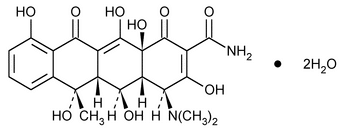Oxytetracycline
(ox'' i tet'' ra sye' kleen).
2-Naphthacenecarboxamide, 4-(dimethylamino)-1,4,4a,5,5a,6,11,12a-octahydro-3,5,6,10,12,12a-hexahydroxy-6-methyl-1,11-dioxo-, [4S-(4
4-(Dimethylamino)-1,4,4a,5,5a,6,11,12a-octahydro-3,5,6,10,12,12a-hexahydroxy-6-methyl-1,11-dioxo-2-naphthacene-carboxamide dihydrate
Anhydrous 460.44
» Oxytetracycline has a potency equivalent to not less than 832 µg of C22H24N2O9 per mg.
Packaging and storage—
Preserve in tight, light-resistant containers.
Labeling—
Where it is intended for use in preparing injectable dosage forms, the label states that it is sterile or must be subjected to further processing during the preparation of injectable dosage forms.
Identification—
Solution:
20 µg per mL.
Medium:
0.1 N hydrochloric acid.
Absorptivity at 353 nm, calculated on the anhydrous basis, is between 96.0% and 104.0% of that of USP Oxytetracycline RS, the potency of the Reference Standard being taken into account.
B:
To 1 mg add 2 mL of sulfuric acid: a light red color is produced.
Crystallinity  695
695 :
meets the requirements.
:
meets the requirements.
pH  791
791 :
between 4.5 and 7.0, in an aqueous suspension containing 10 mg per mL.
:
between 4.5 and 7.0, in an aqueous suspension containing 10 mg per mL.
Water, Method I  921
921 :
between 6.0% and 9.0%.
:
between 6.0% and 9.0%.
Other requirements—
Where the label states that Oxytetracycline is sterile, it meets the requirements for Sterility and Bacterial endotoxins under Oxytetracycline for Injection. Where the label states that Oxytetracycline must be subjected to further processing during the preparation of injectable dosage forms, it meets the requirements for Bacterial endotoxins under Oxytetracycline for Injection.
Assay—
Tetrabutylammonium hydrogen sulfate solution—
Dissolve 1 g of tetrabutylammonium hydrogen sulfate in 100 mL of water. Adjust with 1 N sodium hydroxide to a pH of 7.5.
Edetate disodium solution—
Dissolve 0.04 g of edetate disodium in 100 mL of water. Adjust with 1 N sodium hydroxide to a pH of 7.5.
pH 7.5 Phosphate buffer—
Prepare a mixture of 0.33 M dibasic potassium phosphate and 0.33 M monobasic sodium phosphate (85:15). Adjust, if necessary, by adding more of the appropriate component to a pH of 7.5.
Mobile phase—
Transfer, with the aid of 200 mL of water, 50 g of tertiary butyl alcohol to a 1000-mL volumetric flask. Add 60 mL of pH 7.5 Phosphate buffer, 50 mL of Tetrabutylammonium hydrogen sulfate solution, and 10 mL of Edetate disodium solution, and dilute with water to volume. Degas before use. Make adjustments if necessary (see System Suitability under Chromatography  621
621 ).
).
Standard preparation—
Dissolve an accurately weighed quantity of USP Oxytetracycline RS in 0.01 N hydrochloric acid to obtain a solution having a known concentration of about 0.22 mg per mL.
System suitability solution—
Prepare a solution of tetracycline hydrochloride in 0.01 N hydrochloric acid containing about 0.2 mg per mL. Mix 3 mL of this solution and 1.5 mL of the Standard preparation, and dilute with water to 25 mL.
Assay preparation—
Transfer about 44 mg of Oxytetracycline to a 200-mL volumetric flask, add about 25 mL of 0.01 N hydrochloric acid, swirl to dissolve, dilute with 0.01 N hydrochloric acid to volume, and mix.
Chromatographic system
(see Chromatography  621
621 )—The liquid chromatograph is equipped with a 254-nm detector and a 4.6-mm × 25-cm column that contains packing L21 and is maintained at 60 ± 2
)—The liquid chromatograph is equipped with a 254-nm detector and a 4.6-mm × 25-cm column that contains packing L21 and is maintained at 60 ± 2 . The flow rate is about 1 mL per minute. Chromatograph the System suitability solution, and record the peak responses as directed for Procedure: the relative retention times are about 0.6 for oxytetracycline and 1.0 for tetracycline; and the resolution, R, between the oxytetracycline peak and the tetracycline peak is not less than 5. Chromatograph the Standard preparation, and record the peak responses as directed for Procedure: the tailing factor is not more than 1.25; and the relative standard deviation for replicate injections is not more than 1.0%.
. The flow rate is about 1 mL per minute. Chromatograph the System suitability solution, and record the peak responses as directed for Procedure: the relative retention times are about 0.6 for oxytetracycline and 1.0 for tetracycline; and the resolution, R, between the oxytetracycline peak and the tetracycline peak is not less than 5. Chromatograph the Standard preparation, and record the peak responses as directed for Procedure: the tailing factor is not more than 1.25; and the relative standard deviation for replicate injections is not more than 1.0%.
Procedure—
[note—Use peak areas where peak responses are indicated. ] Separately inject equal volumes (about 20 µL) of the Standard preparation and the Assay preparation into the chromatograph, record the chromatograms, and measure the responses for the major peaks. Calculate the quantity, in µg, of C22H24N2O9 in each mg of the Oxytetracycline taken by the formula:
200(CP / W)(rU / rS)
in which C is the concentration, in mg per mL, of USP Oxytetracycline RS in the Standard preparation; P is the assigned potency, in µg per mg, of USP Oxytetracycline RS; W is the weight, in mg, of the Oxytetracycline taken to prepare the Assay preparation; and rU and rS are the oxytetracycline peak responses obtained from the Assay preparation and the Standard preparation, respectively.
Auxiliary Information—
Please check for your question in the FAQs before contacting USP.
| Topic/Question | Contact | Expert Committee |
|---|---|---|
| Monograph | Ahalya Wise, M.S.
Senior Scientific Liaison 1-301-816-8161 |
(SM12010) Monographs - Small Molecules 1 |
| Reference Standards | RS Technical Services 1-301-816-8129 rstech@usp.org |
USP35–NF30 Page 4185

